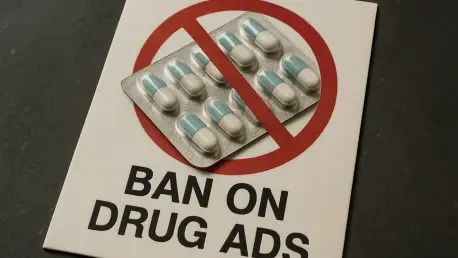In a bold move that has sparked intense debate across the healthcare and advertising sectors, the Trump administration has introduced a groundbreaking initiative to ban direct-to-consumer (DTC) pharmaceutical advertisements on television and impose stricter regulations on undisclosed influencer promotions on social media. This policy, enacted through a presidential memorandum, seeks to dismantle a decades-old framework that has allowed drug companies to market directly to the public, often with minimal transparency about risks. With the support of Health and Human Services Secretary Robert F. Kennedy Jr., the administration aims to prioritize public health over corporate profits, addressing concerns about overmedicalization and deceptive marketing practices. As this initiative unfolds, it raises critical questions about the balance between consumer protection and commercial freedoms, setting the stage for a contentious battle that could reshape the landscape of pharmaceutical advertising.
Examining the Policy Framework
Roots of the Advertising Overhaul
The foundation of this policy lies in reversing a pivotal 1997 FDA guideline that first permitted DTC drug ads on television, a decision that dramatically increased pharmaceutical revenue while flooding airwaves with promotions often criticized for vagueness. Under the new directive, the administration intends to close the “Adequate Provision” loophole, which has long allowed companies to sidestep detailed safety disclosures in their advertisements. This move is paired with a commitment to enhance transparency, particularly on digital platforms where influencer content frequently blurs the line between genuine endorsement and paid promotion. The goal is to ensure that consumers receive balanced information about medications, rather than being swayed by marketing that prioritizes benefits over potential harms. By targeting both traditional and modern advertising channels, the policy reflects a comprehensive approach to tackling what many see as a public health crisis driven by profit motives over patient well-being.
Strategies for Enforcement and Oversight
To implement these changes, the FDA is gearing up to deploy advanced tools, including AI-driven monitoring systems, to scrutinize drug promotions on social media and other digital spaces proactively. This technological push aims to catch violations in real-time, addressing the current gap where only a fraction of ads—especially online—adequately disclose risks. On television, stricter enforcement of existing fair balance guidelines will require ads to present a clearer picture of a drug’s purpose and side effects, moving away from the rapid-fire disclaimers that often confuse viewers. Health and Human Services leaders argue that such measures are essential to rebuild trust in healthcare communications, ensuring that patients are not misled into seeking unnecessary prescriptions. This multi-pronged strategy underscores a broader vision of accountability, though its success hinges on navigating significant pushback from stakeholders accustomed to minimal regulatory interference.
Challenges and Implications for the Future
Industry Resistance and Legal Hurdles
As expected, the pharmaceutical and television industries have voiced strong opposition to the proposed ban, citing substantial financial losses and legal protections under the First Amendment. Drug companies, alongside networks that rely heavily on advertising revenue, are preparing for courtroom battles, drawing on historical precedents where courts have upheld their right to market directly to consumers. Former FDA Commissioner David Kessler has highlighted the likelihood of prolonged litigation, noting that past rulings have often favored commercial speech over public health arguments. This resistance poses a formidable challenge to the administration’s plans, as the economic stakes for these industries are immense. The clash between profit-driven motives and health-focused reforms illustrates a deep divide, with the outcome potentially setting a precedent for how far the government can go in regulating corporate messaging in the healthcare space.
Broader Impact on Public Trust and Health Outcomes
Beyond the immediate legal and financial conflicts, the policy’s long-term impact on public trust and health outcomes remains a critical point of discussion. Critics of current drug advertising practices argue that pervasive marketing contributes to inappropriate drug use, fostering a culture of dependency rather than prevention through lifestyle changes like diet and exercise. If successful, the ban could shift the narrative toward more transparent healthcare communication, empowering consumers to make informed decisions. However, skepticism persists about whether regulatory changes alone can counter the ingrained influence of pharmaceutical marketing. The administration’s push for “radical transparency,” as championed by Kennedy, aims to address the chronic disease epidemic linked to overmedicalization, but achieving measurable improvements will require sustained effort and public buy-in. This initiative, while ambitious, must navigate a complex web of cultural and systemic factors to truly transform health priorities.
Reflecting on a Pivotal Moment
Looking back, the Trump administration’s attempt to ban DTC drug ads and tighten oversight of digital promotions marked a defining chapter in the ongoing struggle to prioritize public welfare over commercial interests. The fierce opposition from pharmaceutical giants and television networks, grounded in legal and economic arguments, underscored the challenges of reforming a deeply entrenched system. Yet, the policy’s emphasis on transparency and accountability offered a glimmer of hope for reshaping how healthcare information reaches the public. Moving forward, stakeholders were encouraged to monitor the evolving legal landscape and advocate for balanced regulations that protect consumers without stifling innovation. Collaborative dialogue between government, industry, and health advocates emerged as a vital next step, ensuring that future policies could bridge the gap between profit and prevention. This moment in history served as a reminder that meaningful change, though fraught with obstacles, remained within reach through persistent and informed action.









